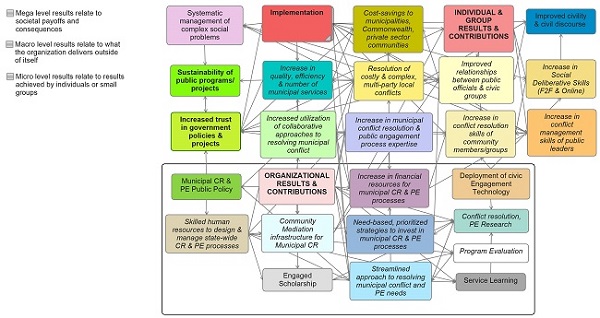Hi! I’m Madhawa “Mads” Palihapitiya, Associate Director at the Massachusetts Office of Public Collaboration at UMass Boston. We recently concluded the first phase of a statewide municipal conflict resolution needs assessment study commissioned by the state Legislature.
Hot Tip: The term “need” can mean many things to many people. For needs assessment purposes, needs are defined as Gaps in Results.
Organizations don’t often think of aligning their institutional needs with the societal bottom-line, but working towards this alignment is crucial. We needed to investigate if our institutional mission, which is to help government and other entities address public conflict, was perfectly aligned with the needs of Massachusetts municipalities and their constituents. This alignment was particularly important to us as a statutory state agency and would add measurable societal value. Overtime, this alignment can also increase the institutional bottom-line.
Rad Resource: Roger Kaufman’s Needs Assessment for Organizational Success. See also Bethany Pearsons’ talk at Evaluation 2014 on the Triple Bottom line.
People don’t usually talk about societal results when they talk about organizational needs. How do we define societal results? We first developed an Ideal Vision that contained a series of societal results and indicators to measure them.
Lesson Learned: We had to resist the impulse to focus on immediate institutional needs like organizational inputs and processes. Imagining an ideal future or vision can tell us where the journey should end.
Rad Resource: Kaufman’s Ideal Vision.
Cool Trick: To help the organization and others being engaged understand the difference between different results, consider developing a visualization like the DoView chart below.
Assessing societal results while assessing the institutional bottom-line requires access to valuable data both within and outside of your organization. A Needs Assessment Committee (NAC) was established as the ‘public face’ of the process and to provide advice and guidance on assessment design, participant selection etc.
Cool Trick: Set-up a website to communicate the purpose of your needs assessment. Use social media whenever possible.
There are 351 cities and towns in Massachusetts. Multiple organizations were involved. We had limited resources to collect the data we needed. We had to get creative! A series of regional focus groups and telephone interviews were held. To reach the rest, we launched an online survey.
Hot Tip: Online surveys are a great way to involve more people. Keep survey questions close-ended and completion time to 10-15 minutes. Plan ahead so that you keep the survey open for as long as you can.
Cool Trick: Get creative with survey dissemination by using contact databases, newsletters, list servers, Facebook and twitter. Ask people you know to invite others to take the survey.
Do you have questions, concerns, kudos, or content to extend this aea365 contribution? Please add them in the comments section for this post on theaea365 webpage so that we may enrich our community of practice. Would you like to submit an aea365 Tip? Please send a note of interest toaea365@eval.org . aea365 is sponsored by the American Evaluation Association and provides a Tip-a-Day by and for evaluators.

